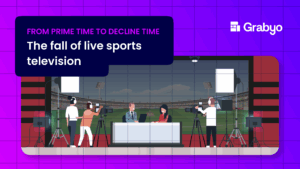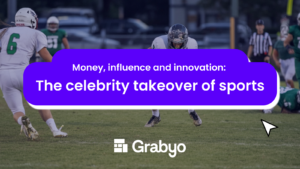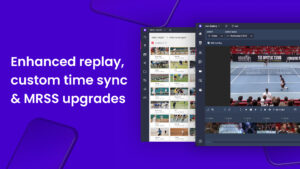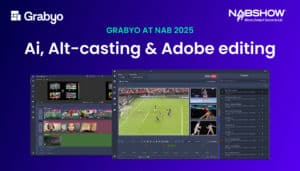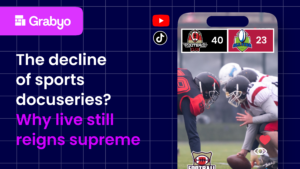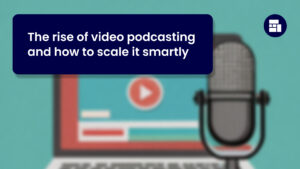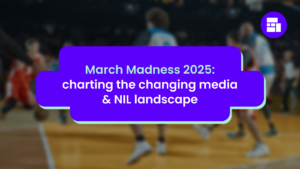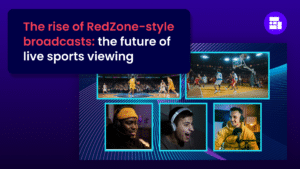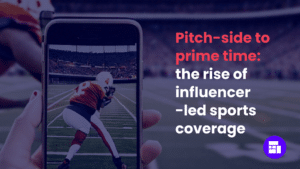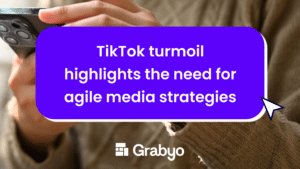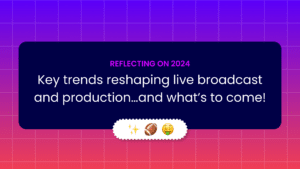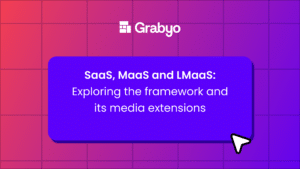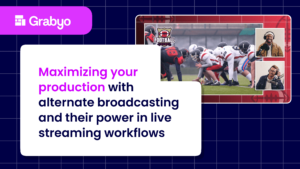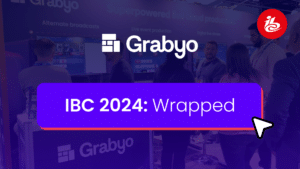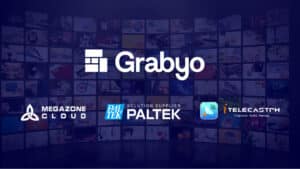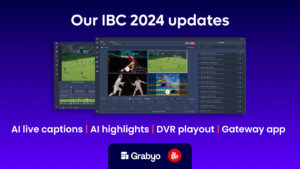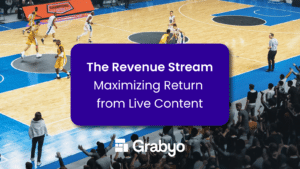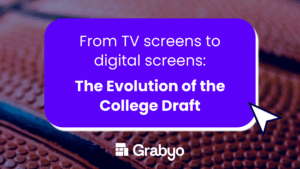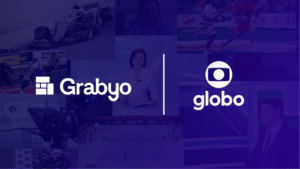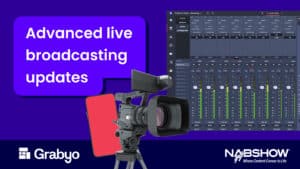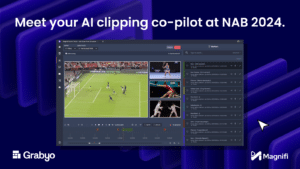
Looking ahead: 2025 live production and social video trends
It’s that time of year we all dust off our crystal balls and look ahead to the next 12 months. Which broadcast and media industry trends need your attention? How should you adapt your video production and distribution strategies to get ahead in 2025?
In this blog we’ll explore what we’ve learned from 2024 and how we see the next year playing out for our industry.
We, not I, Robot
AI made plenty of headlines in 2024 and will continue to do so this year. However, the industry’s understanding of AI is maturing – moving from potential job displacement into more of a collaborative relationship with humans.
AI was a key topic at the 2024 DPP Leader’s Briefing – you can read the highlights in this report. At the briefing, many leaders spoke to seeking the short-term, behind-the-scenes operational efficiencies of AI, holding fire on widespread Gen-AI adoption while the technology evolves. Many major organizations have launched taskforces to investigate Gen-AI adoption, with the focus on human-centered deployment.

At the AI Creative Summit late last year, Grace Boswood, director of technology at Channel 4, highlighted this during a panel with ITN and BBC: “The Generative AI revolution has focused the mind. We are doing activity in three areas. First, we’re creating policies for how we use GenAI. We believe it is there to work in the service of creators, not to replace them, so we’re looking for optimizations around how we create content, not a complete revolution in how it’s created.”
At Grabyo, we share this belief that AI is perfectly poised to empower video production teams to do more with less.
One on hand, media organizations are under pressure to scale live and real-time video production to reach audiences with content as it happens, across multiple platforms – one of the strengths of AI. On the other, audiences engage with content that tells multi-layered, contextual stories that elicit emotion – something in which AI falls short.
It is unlikely, any time soon, that AI will be able to replicate and recognize the key contextual elements that tell the whole story of a live event.
So the question for 2025 – how can AI help to streamline and scale video production while retaining the editorial talents of production teams?
The solution will be finding efficiencies in video workflows, automating areas of production that saves time for your team to identify and create engaging stories.
Current AI workflows
Many organizations are already implementing AI to better utilize CMS and MAM systems, using AI to accelerate content organization, discoverability and retrieval. Companies such as Veritone use AI image recognition to automatically insert metadata into content for these purposes.
AI-powered event detection is also being successfully implemented for real-time video clipping and publishing. AI is now capable of detecting key moments in live broadcasts and automatically publishing content to end points.
But with the limitations of AI discussed above, this workflow isn’t perfect. AI is not yet fully able to recognize additional context or key moments outside of strict instructions it is given, which can lead to missed moments and lower quality content.
However, when these systems are applied to serve production teams with curated content for moderation, editing and publishing, organizations are able to achieve the best of both worlds.

Last year, we launched our human-centered AI highlights solution with Magnifi – which aims to provide a human-centered, AI-powered workflow for live clipping and publishing. You can read more about that here.
The Professional Squash Association is using this workflow to scale video production with a modest-sized team – read more here.
Alt-casting for new audiences
Alternate broadcasting (or alternative broadcasting, or alt-casting) has emerged as the next big thing in fan engagement across live sports.
Alternate broadcasting has existed in some form for many years, but has come to the fore over the past couple of years with many notable alt-casts from top-tier sports across the world.
During 2024, macroeconomic conditions continued to reduce and restrict budgets across the sports and broadcasting industries. A factor that will influence distribution strategies this year.
Alt-casting has become increasingly popular for sports organizations and broadcasters as a way to make existing rights agreements and live content work harder. These organizations are multiplying their live outputs, reaching new audiences and growing revenue without the need to invest large sums in additional hardware. Nor to they need to rely on the production crew’s resources, as digital teams are now empowered to do this on their own, thanks to the cloud.
In 2024, the concept of successful alt-casting was demonstrated by the likes of the NFL and Nickelodeon with SuperBowl coverage aimed at younger audiences – an activation that continues in 2025. A similar tactic was employed by F1 with its F1 Kids TV broadcasts, distributed to international audiences.
While demonstrating the potential of alt-casting, these productions sit at the top-end of deployment. There are also many budget-friendly ways to repackage live sport for new audiences.
NBA franchise LA Clippers also leverage alt-casting to grow its reach worldwide. On the Clippervision app, which allows fans to stream live LA Clippers games, the franchise delivers alternate streams featuring localized, multi-language commentary and graphics on top of the existing game feed.
These streams enable the Clippers to deliver a high-quality, personalized viewing experience for fans with minimal additional production.
Alt-casting will become a key component in 2025 distribution strategies, with pressure on digital and social media teams to continue growing audiences, personalized and localized content has become the focus for cutting through a crowded media landscape.
Alt-casting for increased revenue
Reaching audiences is just one part of the puzzle. Alt-casting enables organizations to create more live content, creating more advertising and sponsorship opportunities.
Ad and sponsorship spend is not immune from challenging economic conditions.It’s likely advertising spend will not increase greatly this year, with much of the focus on tried-and-tested activations and headline events.
Broadcasters and media organizations must demonstrate tangible value to existing brand partners and offer the ability to experiment without long-term commitment. The knock-on effect will be keeping the cost of production to a minimum to prevent losses. This is where alt-casting comes in.
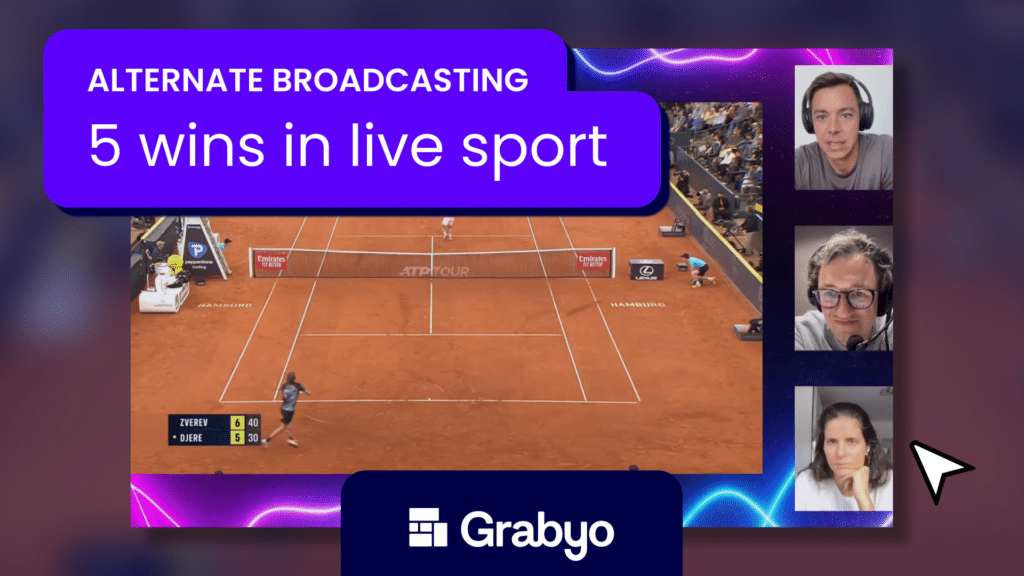
Alternate broadcasting: 5 wins in sport
Discover how leading sports teams and broadcasters are setting the standard for alt-casting success. Learn how you can follow their example to elevate your live content strategy.
With low-cost productions that can be adapted and replaced easily, this risk is minimized. But the strength of alt-casting is not only to offer a low-risk activation, but can go beyond traditional distribution in its audience targeting.
Alt-casts have near limitless options for reformatting live sport. Recruiting new talent for live watchalongs or new commentators can add another dimension to the programming. Influencers and celebrity guests can attract their own audiences that were previously unreachable for sports productions.
This opens up many strategic options for commercial teams to create a ready-made package to sell to prospective sponsors. Attracting audiences with predictable interests are more likely to generate returns for relevant brand partners.
In 2025, we expect to see more test-and-learn activations for major and smaller sports, with maturing in the second half of the year.
What’s in store for social?
Social media platforms are ingrained in any successful distribution strategy for broadcasters and media organizations. The question is no longer if you distribute social video, but how, where and when.
But it’s not just the reach of social media delivering results – these platforms are now major revenue generators.
In 2025, Meta platforms are forecast to overtake linear TV in ad revenue generation globally. While in 2024 YouTube made up a quarter of gross ad revenue in the US.
The opportunities for publishers are here. With audience time spent on linear TV decreasing, and social video viewing increasing, advertisers are increasingly looking to streaming and social, which not only affects ad spend but sponsorship agreements.
This year, scaling live and VOD social video production must be a priority, creating valuable inventory for monetization.

The ultimate guide for generating revenue with video content
See how to generate revenue using live and real-time video content across every channel.
Social platform strategies
How can you ensure your social content strategies are optimized this year? 2025 is not a time for major changes, but incremental testing, experimentation and agility.
IMG’s social platform power ranking, now in its second year, is a helpful tool to see where sports fans are spending the most time, and which platforms are critical for success.
TikTok has been the fastest-growing social platform over the past couple of years, shooting straight into the mainstream. This has prompted other social platforms, such as Facebook and YouTube, to include short-form vertical video formats.
TikTok’s recent updates have included experimenting with longer video times on its platform, giving some creators access to this feature. With the rising popularity of VODcasting (visual podcasting, for the uninitiated) and other popular shoulder content formats, there may be opportunities to trial new formats on the platform.
IMG ranked TikTok as the most important social platform for sports publishers in 2024. This year, that spot belongs to YouTube.
YouTube is a mainstay for online video – the platform reaches more viewers than linear broadcasting and is set to overtake global linear ad revenues. You may be asking, what’s new?
In 2024, we worked with many media organizations across news, sport and entertainment to deliver more live streams to YouTube.
Live streaming to YouTube is not a new concept, but we’ve seen appetite and success from major brands to cement their live YouTube strategy.
With sky-high ad revenues in mind, in 2024 we were part of a small group of 3rd party platforms given access to deliver custom ad insertion into YouTube live streams. Our live streaming platform can now insert ad breaks at any time during a live stream, using RTMP ad markers. These then trigger ad breaks and serve ads using Google’s dynamic ad insertion (DAI) system.

It’s worth noting that audience time spent with online video platforms is outpacing the shift of ad spend to online platforms, partly due to the smaller inventory of ad space. This development will play a part in changing that on the YouTube platform.
We work closely with our partners to ensure Grabyo adapts to changing industry trends and our platform equips teams with the tools to leverage new opportunities for fan engagement and monetization.
For more information on how we can help scale your real-time clipping and publishing workflows, head here. To see how our live production platform enables anyone to produce high-quality live streams, head here.
We wish everyone the best for the year ahead, and look forward to seeing you soon!














